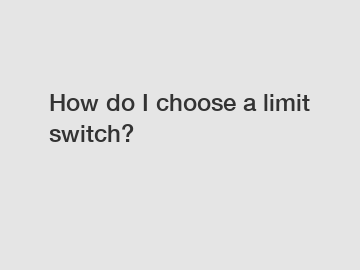How do I choose a limit switch?
How do I choose a limit switch?
When it comes to selecting the right limit switch for your application, there are several factors to consider. Limit switches are essential components in various industries, including manufacturing, automotive, and aerospace. They are used to detect the presence or absence of an object and trigger an action once a specific limit or threshold is reached. With so many options available on the market, it can be challenging to choose the best one for your needs. In this article, we will discuss how to choose a limit switch that meets your requirements.
Types of limit switches.

Before diving into the selection process, it is essential to understand the different types of limit switches available. The two main categories of limit switches are mechanical and electronic. Mechanical limit switches use physical contacts to detect the presence of an object, while electronic limit switches use non-contact sensing technology, such as infrared or ultrasonic sensors. Mechanical limit switches are typically more robust and suitable for harsh environments, while electronic limit switches are more precise and provide faster response times.
Environmental factors.
One of the most critical factors to consider when choosing a limit switch is the environment in which it will be used. Different applications require limit switches with specific protection ratings to ensure reliable operation. For example, if the limit switch will be exposed to dust, water, or extreme temperatures, it is essential to choose a switch with the appropriate IP (Ingress Protection) rating. Additionally, consider factors such as shock and vibration resistance, electromagnetic interference, and corrosion resistance when selecting a limit switch for your application.
Operating conditions.
Another important consideration when choosing a limit switch is the operating conditions of your application. Some limit switches are designed for high-speed applications, while others are more suitable for low-speed operation. Additionally, consider the operating temperature range, voltage and current requirements, and the type of actuator needed for your specific application. It is essential to choose a limit switch that can handle the demands of your application without compromising performance or reliability.
Mounting options.
When selecting a limit switch, consider the mounting options available to ensure proper installation and operation. Limit switches come in various form factors, including panel mount, surface mount, and flush mount, each with its advantages and limitations. Choose a mounting option that fits seamlessly into your existing system and allows for easy access and maintenance. Additionally, consider the spacing requirements and alignment tolerances when installing multiple limit switches in a complex system.
Cost considerations.
While it is essential to choose a limit switch that meets your application requirements, cost is also a crucial factor to consider. Establish a budget for your limit switch selection process and compare prices from different manufacturers to find the best value for your investment. Consider factors such as the initial cost, maintenance requirements, and overall lifecycle costs when evaluating different limit switch options.
Conclusion.
In conclusion, choosing the right limit switch for your application requires careful consideration of factors such as environmental conditions, operating requirements, mounting options, and cost considerations. By understanding the different types of limit switches available and evaluating your specific needs, you can select a switch that meets your requirements and delivers reliable performance. If you need further assistance in choosing a limit switch, do not hesitate to contact us for more information.
Contact us for assistance in choosing the right limit switch for your application.
Want more information on Heavy Duty Limit Switch, Stainless Steel Curving Lever Micro Switch Price, Plastic Rod Cover Limit Switch? Feel free to contact us.
- Previous: Upgrade your automation system with affordable limit switches?
- Next: None

